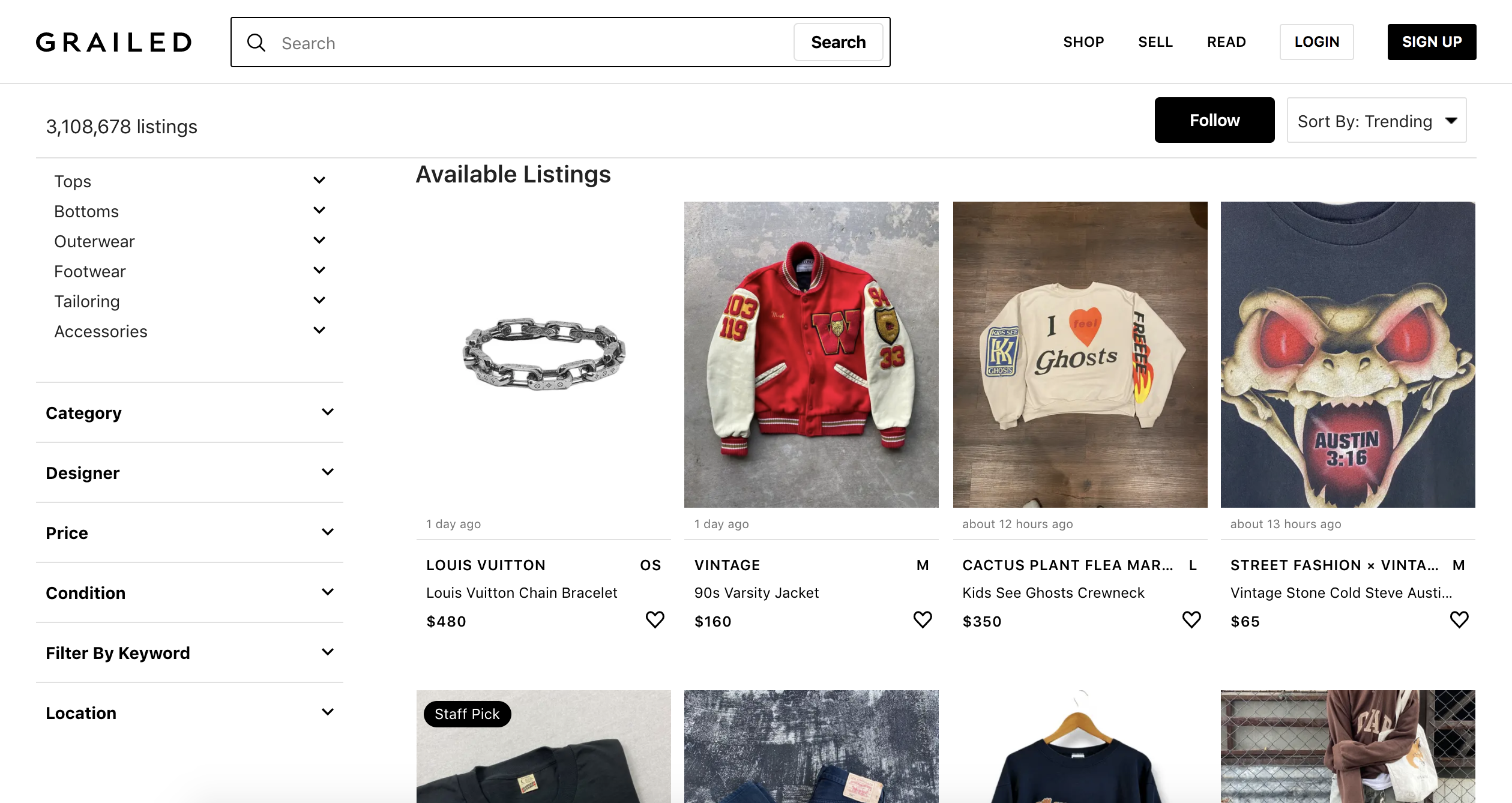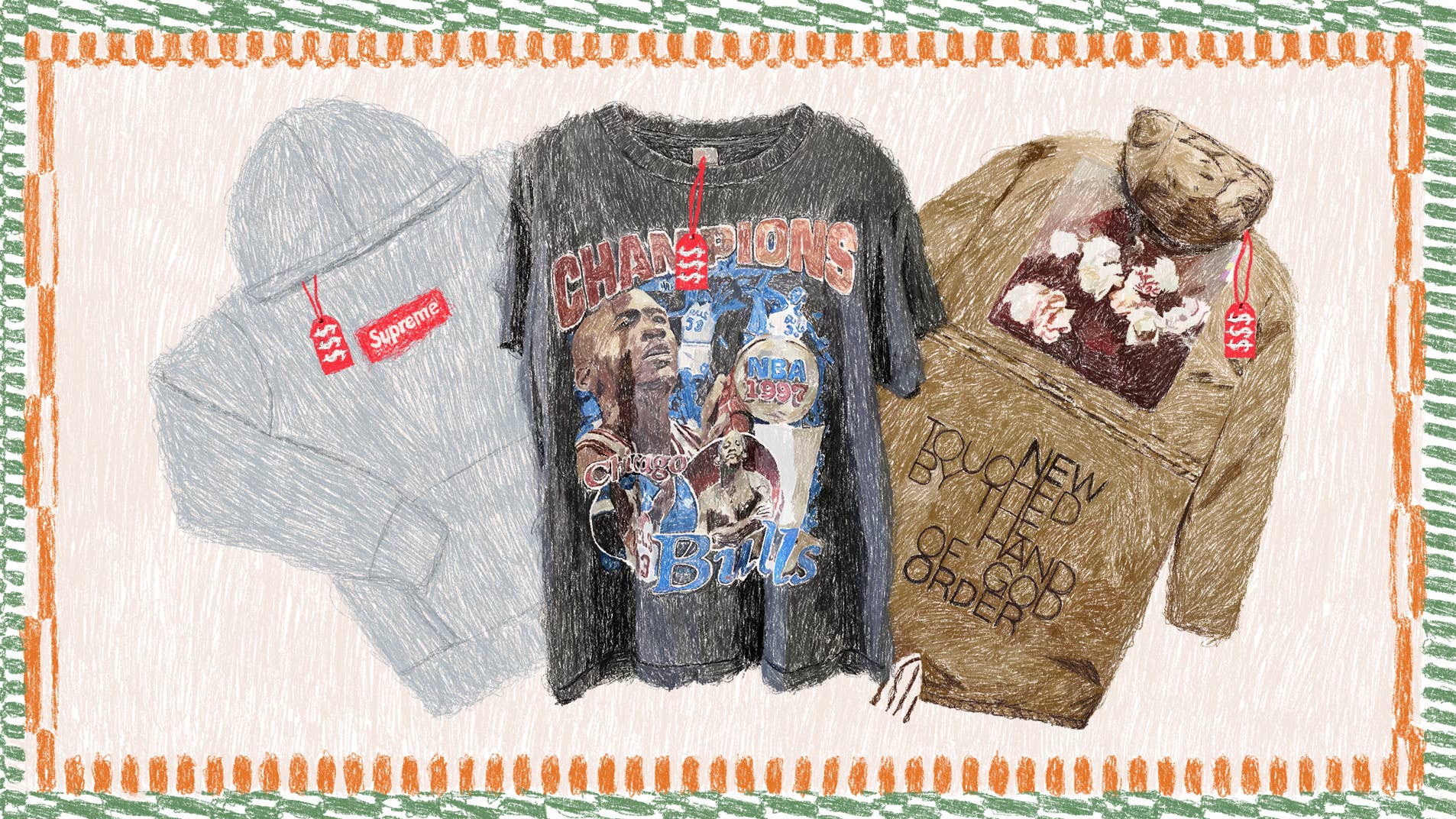
We’ve all seen the photos and videos online—the kid with stacks of Adidas Yeezy boxes in his garage or the guy on the street digging through his newly acquired bags of Supreme goodies on a Thursday morning that will cover rent for the month. Go into almost any shopping mall in any state these days and you will probably see a recently opened consignment shop full of coveted sneaker collabs and streetwear drops. As of this writing, Grailed has 3,118,766 product listings. Reselling is a full-fledged business for plenty of people and despite how crowded the market has become, it can still be a great way to make a bit of money if you know what you’re doing.
“The possibilities are endless. I have friends who do similar things to me who make hundreds of thousands of dollars a year. If you’re buying the right items and selling for the right amount of money, making $100 a day is very possible,” says Grailed seller Adam Ezzell. Ezzell joined the platform back in 2015 and has since accumulated 9,049 transactions with over 6,500 5-star reviews on his page, mom. “Even back when I was just buying stuff from the thrift stores just to pay my rent and buy some food, my goal was $100 every day in profit. I was able to hit that and exceed it with the thrift store stuff.”
Trust me, we know the concept of reselling can be a bit frustrating from the customer’s point of view sometimes. It’s tough to get handed an L when you see the local reseller somehow get their hands on a stockroom’s worth of product. But not all clothing resellers operate in that space. There are those who specialize in archive fashion. There are individuals who operate boutiques dedicated to vintage gear you may not ever be able to find anywhere else. Hey, even if you just want to sell off some of the clothes in your closet for a bit of extra spending money, it’s important to do things the right way. With that being said, we have compiled a few tips we think will help optimize your next reselling venture. Take a look at the full list below.
Getting into reselling may seem a bit overwhelming. There’s money to be made everywhere. It may seem like a good idea to jump right in and start stockpiling as many items as you can from every corner of the fashion world. Some sellers and shops have found success with this approach. Round Two is a prime example. But if you want to ease the burden on yourself when you’re starting out, it may be best to hone in on something particular. For instance, many sellers are dedicated specifically to vintage clothing. Others focus primarily on hyped-up drops from the likes of Supreme or merch from artists like Travis Scott. Sellers like Ezzell on Grailed sell mostly luxury leather goods from brands like Louis Vuitton and Goyard nowadays, but used to sell everything from Nike sneakers to Polo Ralph Lauren pieces. Choosing a specific area will also make it easier to gain knowledge on the products and their history when starting out to make sure you are providing customers with the best possible experience. Over time, you can adapt and expand what you sell to reach a wider audience.
“We sell high ticket items. We sell low ticket items. I’ve sold Supreme. I sell sneakers. We sell a little bit of everything. I was very strict on certain things at first,” says owner of New Jersey-based vintage boutique Past to Present, Joe Vernacchio. “Now I’m starting to open my mind to adapt and have a balance because if you want to be a successful business, you can’t just focus on one customer.”
Pick the Right Platform For You.

To be a successful reseller, it’s crucial to have the knowledge of what you’re actually selling. Thinking that every single item Supreme releases is going to make you rich overnight if you purchase it will set you up for a rude awakening when you are sitting on a bunch of random items that nobody wants. Just because an item was designed by Virgil Abloh does not mean that you will be able to double your money on it. Beyond market interest, knowing the history of a particular brand or subculture can also be vital. Ezzell and Vernacchio both attest to becoming experts in your specific field. That can mean reading up on the history of a designer or speaking with another local seller about the history of a vintage T-shirt you may never have heard of. Authentication is another key pillar of knowledge that every seller should have, to ensure they aren’t peddling counterfeits. The ways to obtain this information are sort of limitless. It’s more about putting in the time to actually care about learning instead of just seeing these items as dollar signs. Being able to answer a customer’s questions about a brand’s sizing or tell the story behind that graphic on the T-shirt they want could be the difference between a sale and someone passing on the item.
“Do research on how to authenticate these items. It’s really important, especially if you’re dealing with something that has a lot of replicas,” says Ezzell. “It’s also important to know general info and history. If you have a customer who’s passionate about what you’re selling and you can have a conversation with them about it, they’ll really appreciate that.”
Study the Market.

Always having products on deck might seem obvious, but it definitely isn’t something you should overlook. That doesn’t mean you need to have hundreds of items ready to sell at all times, but it’s best to always have something for shoppers to take a look at to keep them engaged. Ezzell says he posts a handful of new items daily because he knows there are people who are checking his page frequently to shop. In other cases, he keeps items stashed away depending on the season. For instance, beanies may not sell well in the summertime, but with the colder months approaching there are more people looking for one now. Vernacchio also makes sure to have backstock of items so that he can replenish his store when necessary, which gives frequent customers something to discover when they return.
Price Things Fairly.

Building a community of supporters is a surefire way to guarantee success. One of the easiest ways to do that is through social media. Making an Instagram page to show off your newest pickups or list new products is a perfect example. TikTok is a growing platform, especially for younger shoppers, that could get your business in front of new sets of eyes. Keep an eye out for other sellers in your community or events in your area, too. Ezzell, a Cincinnati resident, says he has friends who own a local shop and always refer customers looking for designer pieces to his Grailed store. Vernacchio has close relationships with most vintage sellers across the tri-state area who do the same.
“It’s stressful dealing with the DMs and all that stuff, but [social media] has done nothing but provide an income for me, provide marketing for me, give me the exposure I need. I have friends in every state and other countries because of Instagram,” he tells Complex. “I truly do believe social media is a huge part of anything you want to do with any type of business.”
Respect Your Customers.

Thousands of people are reselling their clothes around the world. In a lot of instances, everyone is trying to sell the same hoodie or T-shirt too. So, it may seem like your listing is just a random one that someone will hopefully stumble upon in a sea of hundreds. But there are actually some things you can do to set yourself apart and make your listings unique.
Ezzell says that it can be as simple as sending a written “thank you” note with the item you ship, or hitting your local Staples to get a small batch of business cards made. In Vernacchio’s case, he created his own store logo, released merch for shoppers to support, and has a small station at his storefront with a TV for shoppers to relax and catch a few minutes of a movie if they want during their visit. That extra attention to detail may set you apart from everyone else and make the customer realize how serious you are about your business.
As cliche as it may sound, patience is incredibly important in any facet of business. Seeing all of the successful resellers on social media or the exorbitant price that some of these items can sell for may make anyone’s eyes a bit wide. While some people are able to make a very lavish living from their reselling ventures, don’t give up if you aren’t making six figures after a year.
“Patience is huge. Sometimes things will take months to sell to get that price you want. If it doesn’t sell right away, I wouldn’t get discouraged. As long as it’s fairly priced and everything, there’ll always be someone who will buy it eventually,” says Ezzell. He also suggests bumping your items frequently, lowering the price a bit, or even using the proper keywords in a listing to increase sales. “The ability to hold some inventory for a longer period of time will pay off in the end. You don’t want to be taking losses just because you want something to sell quick. It’s not a good way to do business.”
Vernacchio echoes a similar sentiment from his experiences.
“You need patience so you can learn. You can’t expect to jump in it and make a million dollars in a year. It takes time. If you’re not rushing and can do more research, you will be successful in the long run. If you’re jumping into it and think that newest collab is going to make you $1,000 at the end of the week, but you ate shit because it’s a collab nobody wanted, it’s because you didn’t do the research.”

